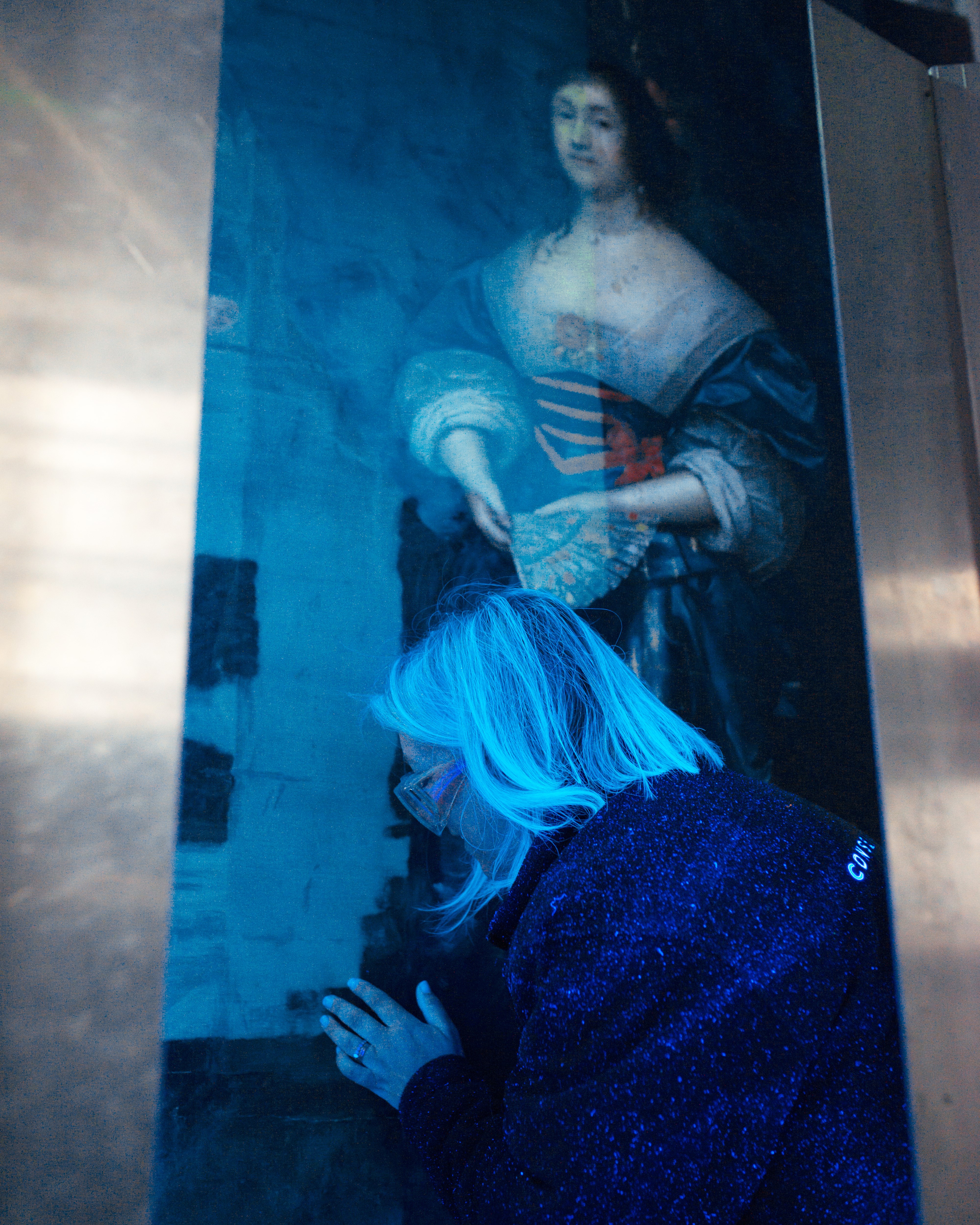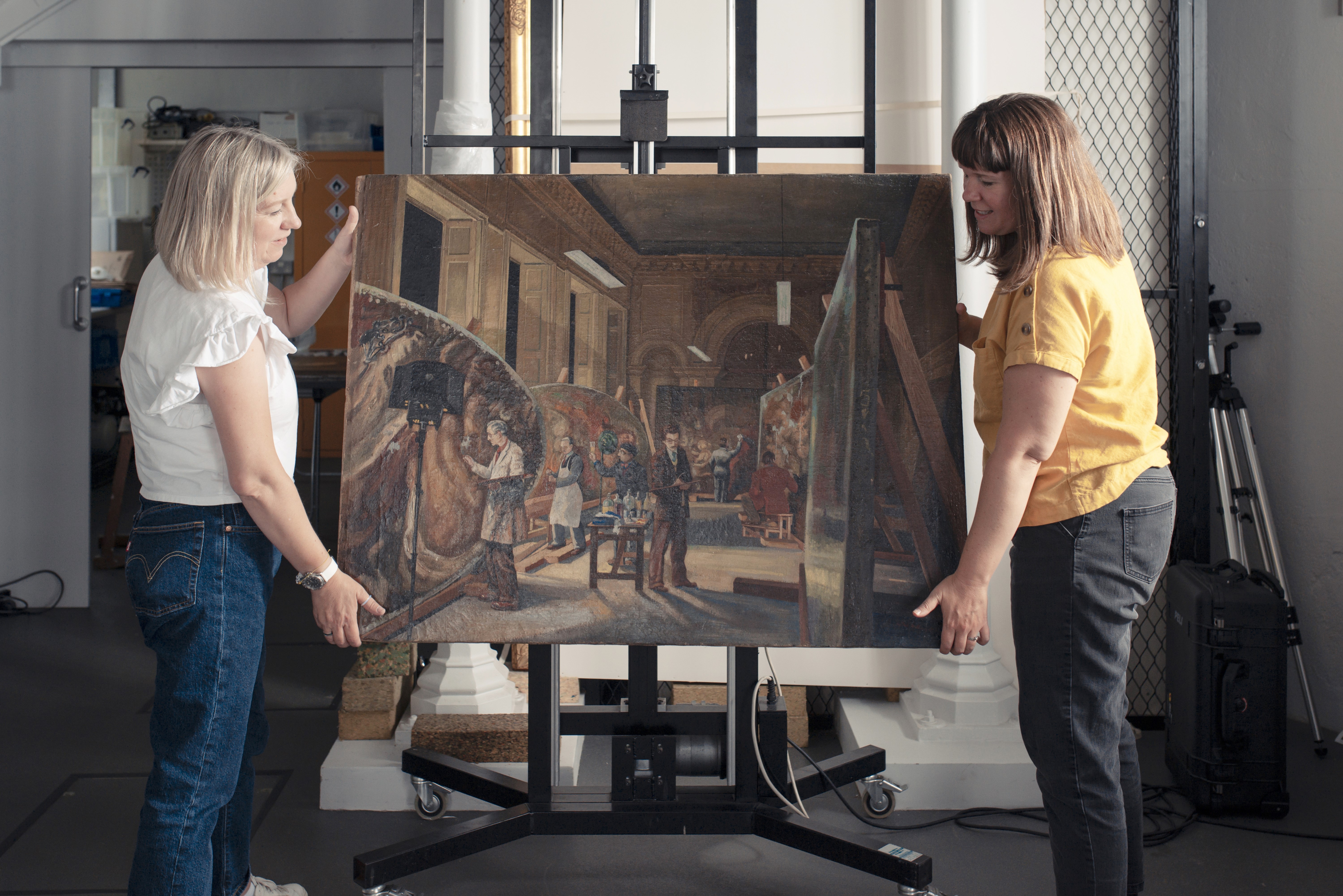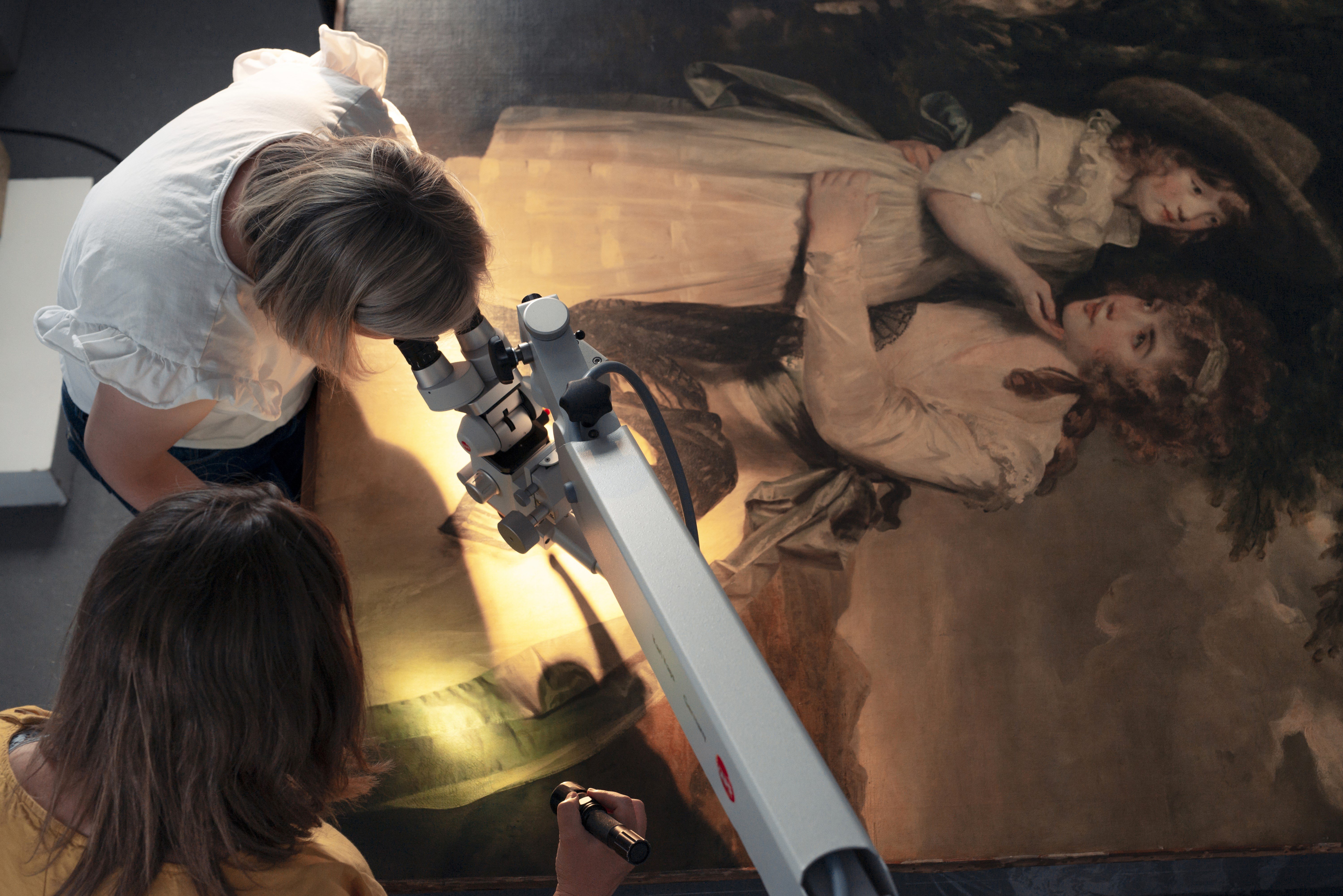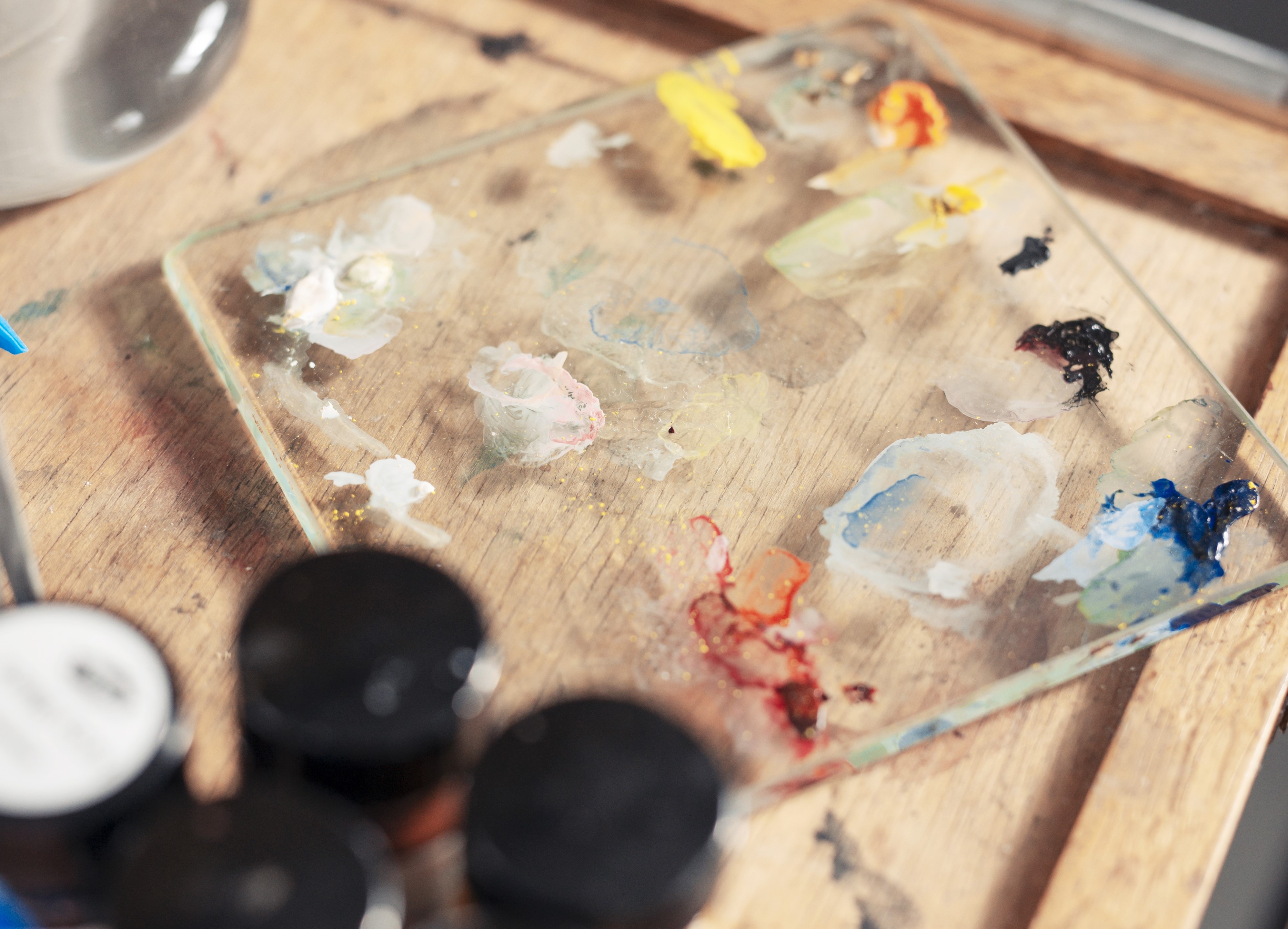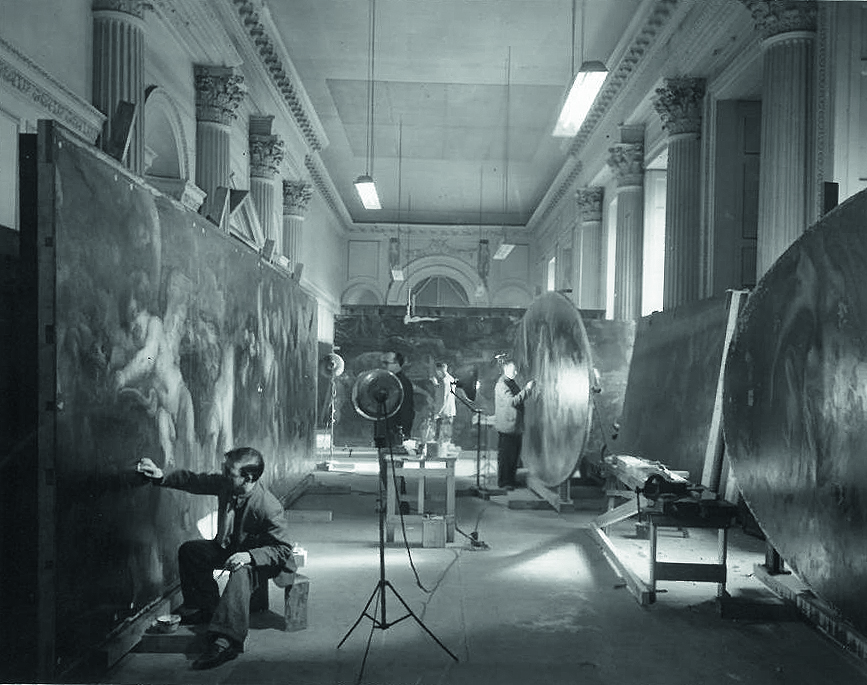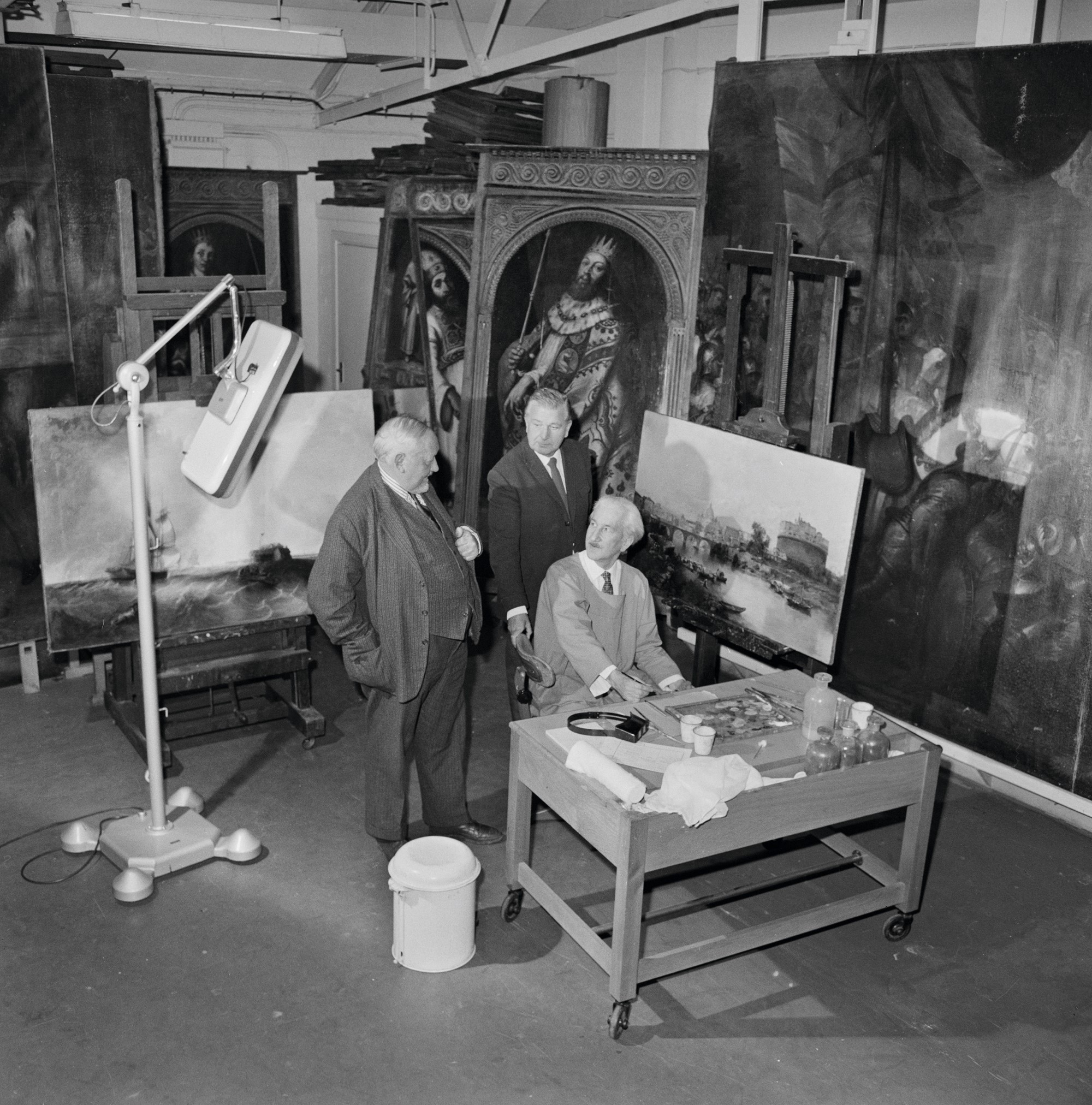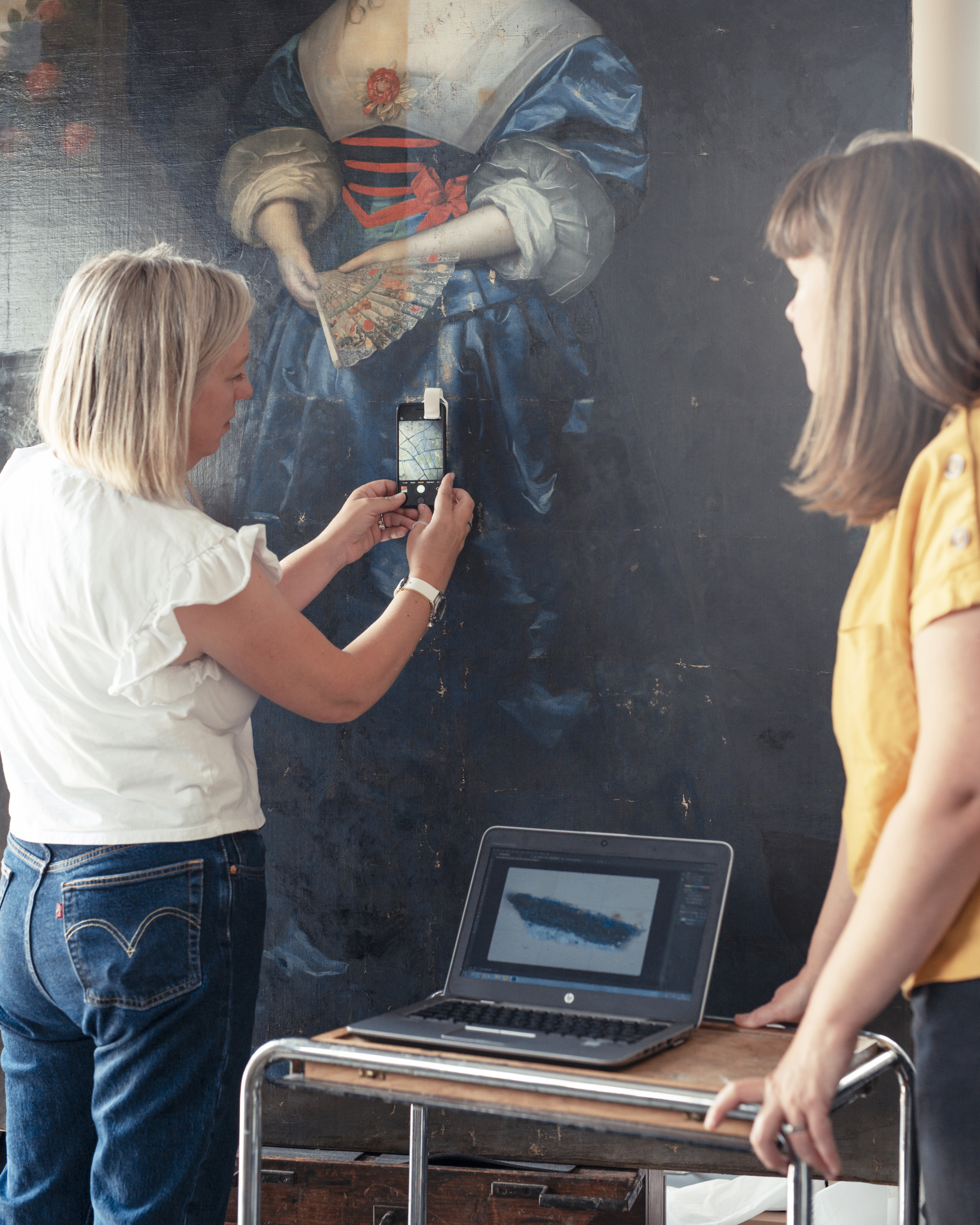Senior collections conservator Rachel Turnbull wheeled a pair of ultraviolet lights into position, handed me some protective glasses and flicked a switch. Bathed in blue light, the layer of old varnish that covers Diana Cecil, 1st Countess of Elgin – a painting by Cornelius Johnson (1593–1661) from the esteemed collection at Kenwood in London – jumped out at us, bright against the area of the painting that’s already been carefully cleaned. It’s like a magic trick.
Looking more closely, the UV light revealed other secrets: damage to the work, areas of historic restoration, and details that had become obscured over the nearly four centuries since Johnson painted this portrait. The best bit? Johnson’s initials and the date he completed this work, 1634, tucked away in a fold of dark drapery, practically impossible to see in normal light.
‘People did know that it was signed but it’s been lost in the last few years,’ said Turnbull, excitedly. She had invited me to take a look around the conservation studio as 2022 marked the centenary of the setting up of the first ever dedicated, government-employed team of artist-restorers tasked with repairing, cleaning and conserving the paintings in the various national collections. There had been museum restoration departments before this point, but they relied on private external workshops. It was only in 1922 that the government’s director of works in charge of royal palaces, the Houses of Parliament, public and historic buildings and ancient monuments began the process of bringing these roles in-house.
SCIENTIFIC APPROACH
The restoration of murals by Frederic Leighton at the Victoria and Albert Museum was a sort of pilot project for a new, more scientific approach, with staff rigorously testing out different treatment techniques to establish the safest and most effective ways of working. A century later, Turnbull and her colleagues, easel-painting conservator Alice Tate-Harte and wall-painting conservator Sophie Stewart, are guided by those same principles as they go about their task of caring for the approximately 1,500 paintings in English Heritage’s collection.
It’s not just the principles that have stood the test of time. ‘There’s a lot of traditional methodology that is still quite sound,’ said Turnbull, at least when it comes to easel paintings. From removing yellowing varnish with swabs and solvents to filling tiny losses and revarnishing, Turnbull and Tate-Harte work in more or less the same way that their forebears would have done. Look around the conservation studio today and you’ll even spot some of the same stools, easels and trolleys used by the team of artists fondly referred to as the ‘men in tweed suits’.
That’s not to say that the current team is stuck in the past. By looking at a painting or a paint sample under UV light, using state-of-the-art infrared imaging, microscopy or X-rays, conservators can learn myriad details about the condition of a work of art. Such tools are also revealing of how an artist worked, their methods and materials, allowing conservators to work together with curators and art historians to gain a better understanding of a painting in its historical context.
Such investigation wasn’t necessarily of much interest to the artist-restorers of yesteryear. ‘They were focused on a painting’s surface and aesthetics,’ said Tate-Harte. ‘When they were doing their restoration they would quite happily repaint things. We just don’t do that.’
"It was estimated that, between 1925 and the Second World War, the team had restored 40,000 square feet of paintings."
It’s important not to judge the efforts of those early restorers too harshly though, she added. ‘They did a great job with the resources that they had and the understanding that they had, and they got through an awful lot of paintings.’
Between 1925 and the outbreak of the Second World War, James Jack, the head of what was by then known as the Artists’ Section, estimated that his six-strong team had restored some 40,000 square feet of paintings in public ownership. Among them were the William Kent murals on the King’s Staircase at Kensington Palace and the 14th-century wall paintings in the Chapter House at Westminster Abbey. A report on these in The Times on 6 April 1929 commented on ‘how astonishingly brilliant some of the pigments become’.
By the 1950s, the Artists’ Section had in its remit some 3,000 paintings – works cared for today by English Heritage as well as Historic Royal Palaces, the Houses of Parliament, the National Trust, the Government Art Collection, Westminster Abbey, the V&A and the Royal Collection. The artists worked fast, either in situ in the case of paintings such as the Thornhill Ceiling at the Old Royal Naval College in Greenwich, or in makeshift studios such as the one set up in the Orangery at Kensington Palace to work on the Rubens ceiling murals from Banqueting House.
Working conditions were far from ideal, as is clear from photographs taken at the time of the artists standing atop towering scaffolds with no safety equipment, using carcinogenic solvents. The Kensington Palace studio wasn’t much better, with one artist writing in March 1947 that there was no heating because they had run out of fuel and that the studio was ‘extremely damp and dangerous to health’. Jack complained in a letter to a manager the following year that ‘it is impossible to imagine any Civil Servant at Lambeth Bridge House writing an important report with rain pouring through the roof’.
New studios
The situation improved after the move, in 1951, to a former army rehabilitation centre in Regent’s Park. This large, spacious studio would be home to the conservators until 2004, through the separation of the collections element of the Department of Education and Ministry of Works into several government agencies in the 1980s, including English Heritage, which was formed in 1983.
The Regent’s Park period also coincided with the development, in the 1960s and ’70s, of scientific research and conservation education that led to the further professionalisation of the discipline. While the early artist-restorers would most likely have attended art school, paintings conservators today complete training that encompasses art history, fine art and the natural sciences.
In 2005 the team moved to the current studio – a bright and modern two-level space whose cast-iron spiral staircase and decorative pillars nod to its former life as an architectural salvage workshop. From a studio staff of around 10 in Regent’s Park, it’s now just Turnbull and Tate-Harte, with Stewart working on wall paintings around the English Heritage portfolio.
But, as Turnbull explained, ‘the resource is still there’ in the form of a much larger team of 30 preventive conservators, scientists and collections care assistants around the country. It’s their job to mitigate risks to the collection from environmental threats such as humidity, light and temperature, to pests, dust and even disaster preparedness.
In the frame
‘Part of our treatment is quite preventive as well,’ Tate-Harte added, pointing towards a carved gilt frame whose back she and Turnbull have built up in order to be able to create a safe environment within which its painting can sit. Where once works were nailed back into frames whose coarse edges would scratch the vulnerable surface of the paintings, now they are carefully cushioned on all sides and protected from accidental damage with a hard back board.
In the case of paintings located in properties whose atmospheric conditions are difficult to control – draughty castles such as Bolsover in Derbyshire, for example – a frame can be designed to create a microclimate for a painting, complete with its own computerised environmental monitoring.
Such technical interventions, as well as an auditing system that prioritises paintings for treatment based on nearly four decades of record keeping, mean that although the team treat far fewer works per year than the ‘men in tweed suits’ once did, the paintings in English Heritage’s care are in better hands than ever before.
‘You are objective in what you choose to treat and why,’ explained Turnbull. ‘We pick the things in the worst condition first.’ In the course of treating the paintings in the collection, the conservators are engaged in a dialogue through history – not just with the original artists but with the restorers who’ve worked on those paintings in the past. Turnbull and Tate-Harte are aware of their own roles in the lives of these works – taking notes and photos of their interventions to help future conservators is a key part of the process. As Tate-Harte put it, ‘Our legacy is to ensure the ongoing preservation of the collection for the next 100 years.’
Three notable paintings that the team have recently conserved at the studio (click each one for more info)
© CROWN COPYRIGHT/HISTORIC ENGLAND ARCHIVE; CHRISTOPHER ISON; LUCY MILLSON-WATKINS; ON LOAN FROM THE WERNHER FOUNDATION; HISTORIC ROYAL PALACES/MARY EVANS PICTURE LIBRARY
MORE TO EXPLORE
-

Listen and learn
Discover more about the work of our paintings conservation team in episode 99 of the English Heritage podcast.
-
See it for yourself
Delve behind the scenes and discover the skill, passion and dedication that goes into restoring and protecting our fine art collection.
-

Discover more
Explore some of our paintings conservation stories and learn about some of the amazing discoveries we have uncovered thanks to our experts’ work.

